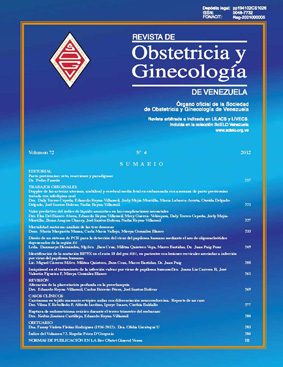Ecografía pélvica: correlación de la evolución de útero y ovarios con estadios de Tanner de mama y edad
Palabras clave:
Ecografía Pélvica, Útero, Ovarios, Estadios de Tanner de Mama, Pelvic Ultrasound, Uterus, Ovaries, Tanner Stages of BreastResumen
Correlacionar la evolución ecográfica de útero y ovarios, según los estadios de Tanner de mama y la edad cronológica en pacientes que acudieron a la consulta de ginecología infantil y juvenil del hospital de niños “Dr. José Manuel de los Ríos” entre marzo y octubre de 2016. Métodos: Se evaluaron 113 pacientes con edades entre 7,7 y 15,5 años, excluyendo aquellas que habían presentado la menarquia, portadoras de malformación uroginecológica, con antecedente de cirugía uterina u ovárica o diagnóstico de alguna endocrinopatía. Se clasificaron según estadios de Tanner de mama y se les realizó ecografía pélvica transabdominal, se midió y describió útero y ovarios. Se calculó la media, desviación estándar y mediana según el tipo de variable, se aplicó ANOVA, prueba no paramétrica H de Kruskal-Wallis y chi-cuadrado de Pearson, se consideró un valor estadísticamente significativo si p < 0,05. Resultados: La longitud uterina varió desde 33 mm en pacientes con Tanner I hasta 52 mm en aquellas con Tanner IV, la relación cuerpo/cuello fue de 0,9 en pacientes con estadio I; 1,12 en estadio II; 1,42 estadio III y 1,30 estadio IV. Se encontró relación estadísticamente significativa entre los volúmenes ováricos tanto con los grupos etarios como con los estadios de Tanner. En cuanto al patrón ovárico, el más frecuente observado fue el microfolicular. Conclusiones: El útero y los ovarios presentan crecimiento continuo en relación a la edad y al estadio de Tanner de mama, factores con los cuales se demostró relación estadísticamente significativa.
To correlate the ultrasound evolution of the uterus and ovaries, according to Tanner’s stages of breast and chronological age in patients attending the children’s and juvenile gynecology clinic of the children’s hospital “Dr. José Manuel de los Ríos “between March and October 2016. Methods: 113 patients aged between 7.7 and 15.5 years were evaluated. From them were excluded those ones who had presented menarche, urogynecologic malformation, endocrinopathy or a history of uterine or ovarian surgery. They were classified according to Tanner stages of breast. Transabdominal pelvic ultrasound was performed, additionally uterus and ovaries were measured and described. We calculated the mean standard deviation and median according to the type of variable, we applied an ANOVA non-parametric test of Kruskal-Wallis and chi-square of Pearson, it can be considered a statistically significant value if p <0.05. Results: Uterine length ranged from 33 mm in patients with Tanner I up to 52 mm in those with Tanner IV. Body/cervix ratio was 0.9 in patients with stage I, 1.12 with stage II, 1.42 with stage III and 1.30 with stage IV. A statistically significant relationship was found between ovarian volumes with both age groups and Tanner stages. As for the ovarian pattern, the most frequent one was the microfollicular. Conclusions: The uterus and ovaries show continuous growth in relation to age and the Tanner stage of breast, those factors with which a statistically significant relationship was demonstrated.

